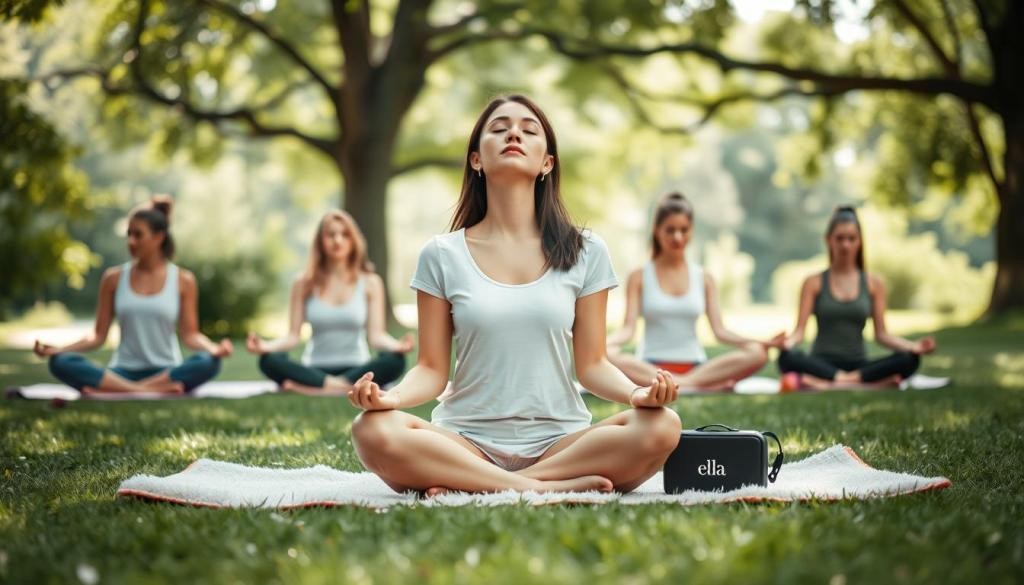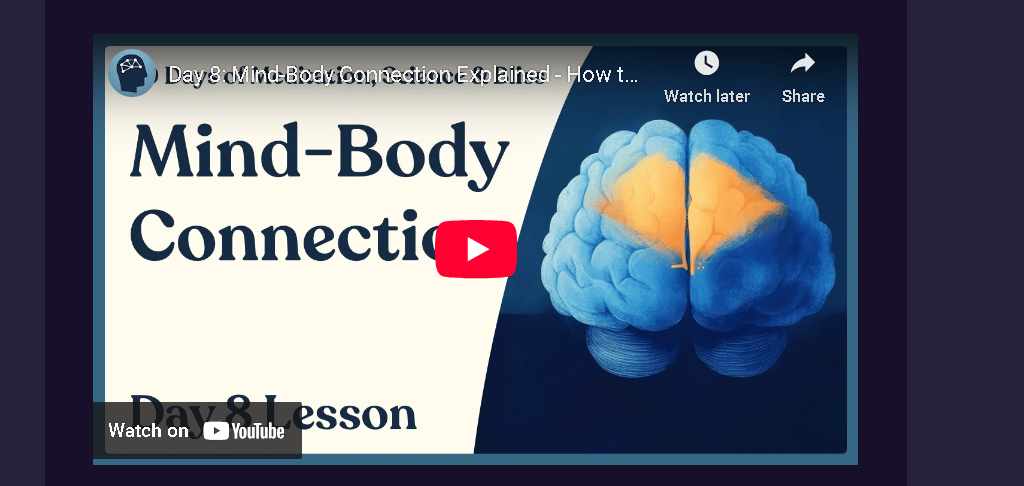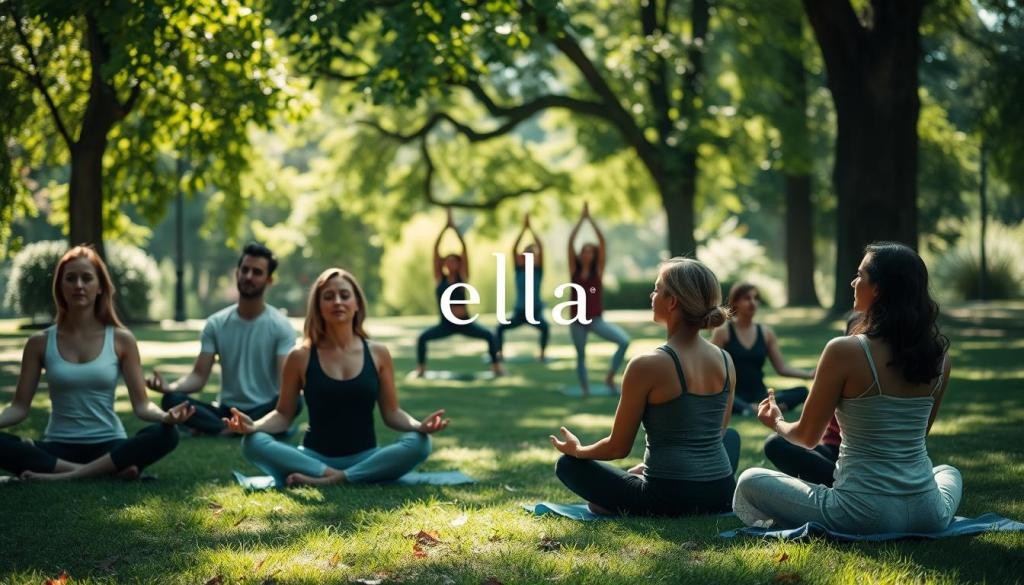Unlock the Power of Control and Meditation!
👉 Discover how control and meditation can transform your daily life—find focus, calm, and inner strength starting today!
Elena Dan
10/2/202512 min read


Unlock the Power of Control and Meditation!
By Elena / July 17, 2025
As mothers, we’re constantly seeking ways to improve our lives and the lives of those around us. One powerful tool for achieving this is meditation, which helps us gain control of our whole being. By dedicating time to meditate, we can reduce stress, increase focus, and cultivate a deeper sense of inner peace.
Through meditation, we can develop a greater sense of self-awareness, allowing us to make more intentional decisions and live a more balanced life. As we explore the benefits of meditation and control, we’ll discover how these practices can lead to personal growth and wellness.
Key Takeaways
Meditation helps reduce stress and increase focus.
Developing self-awareness through meditation leads to more intentional decision-making.
Practicing meditation and control can result in a more balanced life.
Mothers can benefit from meditation for personal growth and wellness.
Regular meditation practice cultivates inner peace and well-being.
The Modern Mother’s Challenge: Finding Balance in Chaos
Today’s mothers are juggling multiple responsibilities, making it difficult to find balance in their chaotic lives. The role of a mother has evolved significantly, involving not just childcare but also managing the household and often working outside the home.
The Unique Stressors Facing Today’s Mothers
Modern mothers face a myriad of stressors that are both physical and emotional. These challenges can be broadly categorized into physical demands and emotional labor.
Physical Demands and Sleep Deprivation
The physical demands of parenting are significant, from the exhaustion that comes with caring for a newborn to the constant activity required to keep up with growing children. Sleep deprivation is a common issue, affecting both the physical and mental health of mothers.
Emotional Labor and Mental Load
In addition to physical demands, mothers often bear the brunt of emotional labor, managing the emotional well-being of their family members and handling household responsibilities. This mental load can be overwhelming, leading to stress and burnout.
Why Traditional Self-Care Advice Often Falls Short
Traditional self-care advice, such as bubble baths and spa days, often doesn’t address the root causes of stress and burnout. Mothers need practical, mindfulness techniques and mind-body connection exercises that can be integrated into their daily lives to manage stress effectively.
Practicing mindfulness during routine activities
Engaging in physical activities that promote well-being
Seeking support from family, friends, or support groups
By adopting these strategies, mothers can better navigate the challenges of modern parenting and find a more balanced, fulfilling life.
Understanding the Mind-Body Connection
As mothers, we often overlook the intricate link between our thoughts, emotions, and physical well-being, but understanding this connection is crucial for our overall health. The mind-body connection is a complex interplay that significantly influences our health and resilience, especially in the face of stress.
The Science Behind How Thoughts Affect Physical Well-being
The relationship between our thoughts, emotions, and physical health is rooted in the complex interactions within our body’s systems. When we experience stress or negative emotions, our body releases stress hormones like cortisol and adrenaline. These hormones prepare our body for the “fight or flight” response, causing changes such as increased heart rate, blood pressure, and energy supplies.
Stress Hormones and Their Physical Impact
Chronic stress can lead to an overproduction of stress hormones, negatively impacting our physical health. This can result in issues such as hypertension, digestive problems, and a weakened immune system. Understanding the role of stress hormones is crucial for managing our physical response to stress.
Recognizing Your Body’s Stress Signals
It’s essential to recognize the signs that our body is under stress. These can include physical symptoms like headaches, muscle tension, and fatigue, as well as emotional changes such as irritability or anxiety. By being aware of these signals, we can take proactive steps to manage our stress.
Creating Your Personal Stress Response Inventory
To effectively manage stress, we recommend creating a personal stress response inventory. This involves tracking the situations that trigger stress, the physical and emotional symptoms we experience, and the coping strategies that work best for us. By understanding our unique stress response, we can develop targeted self-care practices that address our specific needs.
By understanding the mind-body connection and recognizing our body’s stress signals, we can take the first steps towards holistic self-care and self-mastery. This knowledge empowers us to make informed choices about our health, leading to a more balanced and fulfilling life.
Control of Your Whole Being: The Foundation of Transformation
Self-mastery is not just a goal; it’s a foundational element for lasting personal transformation. To achieve true control over our whole being, we must understand that it’s a multifaceted concept involving the integration of our mind, body, and spirit.
Defining True Self-Mastery
True self-mastery involves having a deep understanding of ourselves, including our thoughts, emotions, and physical responses. It’s about being in control of our reactions and making conscious decisions that align with our goals and values. Mastering self-discipline is a crucial aspect of this journey, as it enables us to stay focused and committed to our personal growth.
The Three Pillars: Mind, Body, and Spirit
Our well-being is supported by three interconnected pillars: mind, body, and spirit. Each pillar plays a vital role in our overall health and must be nurtured accordingly.
Why Integration Is Key to Lasting Change
Integrating the mind, body, and spirit is essential for achieving lasting change. When we work on one aspect without considering the others, we risk creating imbalance. For instance, improving physical health without addressing mental well-being can lead to burnout.
Breaking the Cycle of Fragmented Self-Improvement
Many self-improvement approaches focus on a single aspect of our being, leading to fragmented growth. To break this cycle, we must adopt a holistic approach that considers our entire being. This involves practices like inner emotional control, which helps us manage our emotions and reactions, leading to more balanced and effective personal growth.
By understanding and implementing the principles of self-mastery, we can achieve a more balanced and fulfilling life. It’s a journey that requires commitment, patience, and self-awareness, but the rewards are immeasurable.
Essential Meditation Practices for Busy Mothers
In the chaos of daily life, meditation offers a much-needed pause for busy mothers. By incorporating meditation into their daily routine, mothers can enhance their psychological self-control techniques, leading to a more balanced life.
Breath-Focused Meditation Techniques
Breath-focused meditation is a simple yet powerful technique that can be done anywhere, at any time. It involves focusing your attention on your breath, observing its pattern, and letting go of distracting thoughts.
Box Breathing for Instant Calm
Box breathing is a technique where you breathe in for a count of 4, hold your breath for a count of 4, exhale for a count of 4, and then hold your breath again for a count of 4. This creates a “box” shape with your breath, promoting calmness and reducing stress.
Counting Breath for Better Sleep
Counting your breath can help calm your mind and prepare your body for sleep. Simply count each breath, starting from one and going up to ten, and then start again. This technique can help you relax and improve the quality of your sleep.
The STOP Technique for Emotional Regulation
One effective technique for regulating emotions is the STOP method:
S – Stop what you’re doing. Take a moment to Guided Visualization for Energy Restoration
Guided visualization involves using your imagination to create a mental scenario that promotes relaxation and rejuvenation. By visualizing a peaceful scene or a positive outcome, you can restore your energy and improve your mental well-being.
Body Scan Meditation for Physical Tension Release
Body scan meditation involves lying down or sitting comfortably and bringing your attention to different parts of your body, starting from your toes and moving up to your head. As you focus on each area, release any tension or discomfort, allowing your body to relax and feel more at ease.
By incorporating these meditation practices into their daily routine, busy mothers can experience a significant improvement in their overall well-being, enhancing their ability to manage stress and maintain a sense of calm amidst chaos.
Mindfulness Techniques for Daily Life Integration
Mindfulness isn’t just a practice; it’s a way of living that can transform our daily experiences. By incorporating mindfulness techniques into our routine, we can reduce stress and increase our overall sense of well-being.
Micro-Meditation Practices (2-5 Minutes)
Micro-meditations are short, focused mindfulness exercises that can be done anywhere, anytime. These brief moments of mindfulness can help us stay grounded and centered throughout the day.
Take a few deep breaths, focusing on the sensation of the breath.
Notice your surroundings, using your senses to ground yourself.
Practice a quick body scan, releasing any tension.
Mindful Moments During Routine Activities
Daily activities like dishwashing, driving, and even walking can become opportunities for mindfulness practice.
Dishwashing Meditation
Transform dishwashing into a meditative experience by focusing on the sensation of the water, the sound of the suds, and the smell of the soap. This mindfulness technique turns a mundane task into a moment of peace.
Mindful Driving and Commuting
Use your commute as a time for mindfulness by paying attention to your breath, the sensation of your feet on the floor, or the sounds around you. This can turn a potentially stressful time into a moment of calm.
Teaching Children Mindfulness While Learning Yourself
As mothers, we have the unique opportunity to teach our children mindfulness techniques while we practice them ourselves. This not only benefits us but also helps our children develop healthy coping mechanisms from a young age.
Developing Inner Emotional Control
In the midst of chaos, finding emotional balance is crucial for maintaining your well-being and being the best version of yourself for your family. Developing inner emotional control is a powerful step towards achieving this balance, and it’s a fundamental aspect of holistic self-care. By gaining control over our emotions, we can respond to challenging situations more thoughtfully, rather than react impulsively.
Identifying Your Emotional Triggers
The first step in developing emotional control is understanding what triggers your emotions. For mothers, these triggers can range from a child’s tantrums to the pressure of managing household chores. Creating a trigger journal can be a helpful tool in this process.
Creating a Trigger Journal
A trigger journal is a simple yet effective way to track and understand your emotional responses. By recording the situations that trigger strong emotions, you can begin to identify patterns and common themes. This awareness is the first step towards managing your reactions more effectively.
Note the situation or event that triggered the emotion.
1. Record the emotion you felt (e.g., angerpause.
2. T – Take a breath. Focus on your breathing to calm your mind and body.
3. O – Observe your thoughts and feelings without judgment.
4. P – Proceed with a response that is more thoughtful and considered.
This simple technique can help you manage your emotions in the heat of the moment, leading to more positive outcomes in your interactions with your family.
Creating Emotional Boundaries Without Guilt
Setting emotional boundaries is crucial for maintaining your emotional well-being. It’s about learning to say “no” without feeling guilty and being clear about what you are and aren’t comfortable with.
Phrases for Setting Boundaries with Family and Friends
Having a few simple phrases at hand can make setting boundaries easier. Here are some examples:
“I’m focusing on my own well-being right now, so I’d prefer not to take on that task.”
“I need some time to myself. Can we discuss this later?”
“I’m happy to help, but I need to set some limits on how much I can do.”
By setting clear boundaries, you’re practicing holistic self-care and ensuring that you have the emotional resources to care for your family effectively.
Holistic Self-Care Practices That Transform
Holistic self-care is more than just a buzzword; it’s a transformative approach to nurturing our overall well-being. As mothers, embracing holistic self-care can be a game-changer for enhancing our resilience and ability to care for our families.
Beyond Bubble Baths: Meaningful Self-Care
While bubble baths can be relaxing, true self-care goes beyond superficial relaxation techniques. It involves meaningful practices that nurture our mind, body, and spirit. This includes integrating movement, nutrition, and rest into our daily routines to support our overall health.
Integrating Movement, Nutrition, and Rest
A holistic approach to self-care involves balancing physical activity, healthy eating, and adequate rest. This balance is crucial for maintaining energy levels and supporting mental health. By incorporating self-mastery methods such as mindful movement and nutrition planning, we can enhance our well-being.
Self-Care Aspect
Practices
Benefits
Movement
Yoga, walking, dancing
Improved physical health, reduced stress
Nutrition
Balanced meals, healthy snacking
Enhanced energy, better mood
Rest
Adequate sleep, relaxation techniques
Improved mental clarity, reduced fatigue
Creating Rituals That Restore Your Energy
Establishing daily rituals can significantly impact our energy levels and overall sense of well-being. By creating morning and evening rituals, we can set ourselves up for centered days and restorative sleep.
Morning Rituals for Centered Days
Starting the day with a mindful practice, such as meditation or journaling, can help set a positive tone. This intentional beginning can enhance our mental clarity and prepare us for the day’s challenges.
Evening Rituals for Restorative Sleep
Engaging in calming activities before bed, such as reading or a warm bath, can signal to our bodies that it’s time to rest. This can improve the quality of our sleep and support our overall health.
By embracing these holistic self-care practices and incorporating self-mastery methods, we can transform our lives and enhance our ability to thrive as mothers.
Mastering Self-Discipline: The Gateway to Freedom
By embracing self-discipline, we empower ourselves to make meaningful changes in our lives. Self-discipline is not about restriction; it’s about creating a framework that allows us to achieve our goals and live a more balanced life.
Reframing Discipline as Self-Respect
We often view discipline as a negative constraint, but it’s actually a form of self-respect. When we commit to a goal or habit, we’re showing respect for ourselves and our aspirations. This mindset shift is crucial for mastering self-discipline.
Building Consistency Through Tiny Habits
Consistency is key to developing self-discipline. By starting with tiny habits, we can build momentum and confidence. This approach helps us integrate positive behaviors into our daily routine, making it easier to stick to our goals.
The 2-Minute Rule for New Habits
The 2-minute rule is a simple yet effective strategy for building new habits. If a task can be done in less than 2 minutes, it’s often a good starting point. This rule helps us overcome the initial resistance to new behaviors.
Habit
Initial Effort
Long-term Benefit
Meditation
2 minutes daily
Reduced stress, improved focus
Journaling
5 minutes daily
Enhanced self-awareness, better goal tracking
Exercise
10 minutes daily
Increased energy, improved physical health
Overcoming the Motivation Myth
Many believe that motivation is necessary for self-discipline, but this is a myth. Self-discipline is about creating systems and habits that support our goals, regardless of our motivation levels. By focusing on inner emotional control, we can maintain our commitment to our objectives.
Conclusion: Your Journey to Wholeness and Control
As we conclude our exploration of meditation, mindfulness, and self-control techniques, we encourage you to continue on this transformative journey. By integrating these practices into your daily life, you’ll cultivate control of your whole being, leading to greater balance and harmony.
We’ve discussed various methods to achieve this integration, from breath-focused meditation to mindful moments during routine activities. By applying these psychological self-control techniques, you’ll be better equipped to manage stress and navigate life’s challenges with greater ease.
As you move forward, remember that the path to wholeness is a continuous process. Be patient and compassionate with yourself as you work to develop greater self-awareness and self-regulation. With consistent practice, you’ll experience profound shifts in your overall well-being and quality of life.
We invite you to embrace this journey, exploring the depths of your inner world and unlocking your full potential. By doing so, you’ll not only enhance your own life but also positively impact those around you.
FAQ
What is meditation, and how can it benefit mothers?
Meditation is a practice that involves focusing one’s mind for a period of time to achieve a state of relaxation and inner peace. For mothers, meditation can help reduce stress, improve emotional regulation, and increase overall well-being, leading to a more balanced and fulfilling life.
How can mindfulness techniques be integrated into daily life?
Mindfulness techniques can be integrated into daily life through practices such as micro-meditations, mindful moments during routine activities like dishwashing and driving, and teaching children mindfulness. These practices can help mothers cultivate greater awareness and calm in their daily lives.
What is self-mastery, and how can it be achieved?
Self-mastery refers to the control of one’s whole being, encompassing the integration of mind, body, and spirit. It can be achieved through practices such as meditation, mindfulness, and holistic self-care, which help individuals develop greater self-awareness, emotional regulation, and inner emotional control.
How can mothers develop inner emotional control?
Mothers can develop inner emotional control by identifying their emotional triggers, using techniques like the STOP technique for emotional regulation, and creating emotional boundaries without guilt. This can help them better manage their emotions and respond to challenging situations more mindfully.
What is holistic self-care, and how can it be practiced?
Holistic self-care involves integrating movement, nutrition, and rest to promote overall well-being. Mothers can practice holistic self-care by creating rituals that restore energy, such as morning and evening rituals, and engaging in activities that nourish their mind, body, and spirit.
How can self-discipline be cultivated, and what role does it play in achieving personal freedom?
Self-discipline can be cultivated by reframing discipline as self-respect, building consistency through tiny habits, and overcoming the motivation myth. Self-discipline plays a crucial role in achieving personal freedom by enabling individuals to make choices that align with their values and goals, leading to greater autonomy and self-mastery.
Can meditation and mindfulness practices be beneficial for children as well?
Yes, meditation and mindfulness practices can be beneficial for children, helping them develop greater self-awareness, emotional regulation, and resilience. Teaching children mindfulness can also promote a mindful family culture and support their overall well-being.





